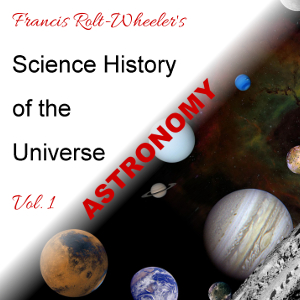-
1
00 - Introduction
-
2
01 - Ch 1 - The Evolution of Astronomical Ideas
-
3
02 - Ch 2, Part 1 - The Evolution of Observational Methods
-
4
03 - Ch 2, Part 2 - The Evolution of Observational Methods
-
5
04 - Ch 3 - The Rise of Astrophysics
-
6
05 - Ch 4 - Celestial Photography
-
7
06 - Ch 5 - The Law of Gravitation
-
8
07 - Ch 6 - Planetary Distances
-
9
08 - Ch 7 - Planetary Motions
-
10
09 - Ch 8, Part 1 - The Solar System
-
11
10 - Ch 8, Part 2 - The Solar System
-
12
11 - Ch 9, Part 1 - The Sun
-
13
12 - Ch 9, Part 2 - The Sun
-
14
13 - Ch 10, Part 1 - Solar Energy
-
15
14 - Ch 10, Part 2 - Solar Energy
-
16
15 - Ch 11 - Mercury
-
17
16 - Ch 12, Part 1 - Venus
-
18
17 - Ch 12, Part 2 - Venus
-
19
18 - Ch 13, Part 1 - The Earth
-
20
19 - Ch 13, Part 2 - The Earth
-
21
20 - Ch 14, Part 1 - The Moon
-
22
21 - Ch 14, Part 2 - The Moon
-
23
22 - Ch 15, Part 1 - Mars
-
24
23 - Ch 15, Part 2 - Mars
-
25
24 - Ch 16 - Jupiter
-
26
25 - Ch 17 -Saturn
-
27
26 - Ch 18 - Uranus and Neptune
-
28
27 - Ch 19 - The Planetoids
-
29
28 - Ch 20, Part 1 - Comets, Meteors and Meteorites
-
30
29 - Ch 20, Part 2 - Comets, Meteors and Meteorites
-
31
30 - Ch 20, Part 3 - Comets, Meteors and Meteorites
-
32
31 - Ch 21, Part 1 - The Constellations
-
33
32 - Ch 21, Part 2 - The Constellations
-
34
33 - Ch 22 - The Motions of the Stars
-
35
34 - Ch 23, Part 1 - Variable and Binary Stars
-
36
35 - Ch 23, Part 2 - Variable and Binary Stars
-
37
36 - Ch 24, Part 1 - Nebulae and Star Clusters
-
38
37 - Ch 24, Part 2 - Nebulae and Star Clusters
-
39
38 - Ch 25, Part 1 - Cosmogony and Stellar Evolution
-
40
39 - Ch 25, Part 2 - Cosmogony and Stellar Evolution
